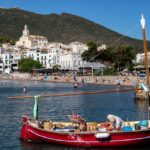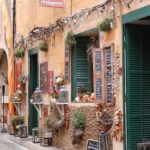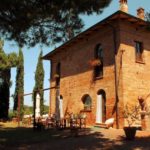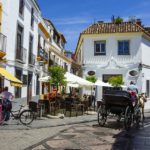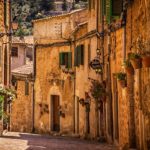Unknown Catalonia: My Accidental Visit to Anglés

Famed Spanish poet Federico Garcia Lorca wrote that “In Spain, the dead are more alive than the dead of any other country in the world.” Indeed. Spain is a manifestation of life, and here people know how to live it (although this may be the reason Spain’s economy does not perform as well as some). But to me, Spain is the most lively, enchanting, charismatic, and unrestrained place—there is no such country as Spain in one hundred words.
When you live in the motherland of Dalí, Bacardi and Gaudí, you don’t go to bed after returning home at 3 am, you go for a dinner. Here, the hottest month is August. Here, people hardly speak English but will love you and make friends with you once you say a word in Spanish.
Small cozy cafes are in every patio, where inhabitants from neighboring houses gather in the morning to read El Pais or La Vanguardia and to have a cup of delicious cafe con leche (coffee with milk), just as good as Italy’s famed coffee.
Spain is a manifestation of life, and here people know how to live it.
In the evening, the same neighbors meet in the city center for dinner to discuss and gossip, discuss and gossip. Spanish people see nothing disgraceful in discussing and criticizing someone else’s personality, as well as their own. Even a considerable part of Spanish daily television news is given to gossip, such as the queen being noticed in bikini… what can I say? The country is small and generally safe, and there is not much to discuss in the news besides Mario Draghi’s Quantitative Easing, the markets turmoil and separatist movements.
I’ve visited Spain for several times, with my longest stay being two months in Valencia where I went to improve my Spanish and sleepwalked my way to adoring this country. However, the primary subject of my interest has been Catalonia crowned by Barcelona—traditionally the main travel interest for 90 percent of Russians. That is why not a single word will be devoted to it. Neither will I speak about Sitges or Girona which are also authentic and gorgeous in their own way.
Let me tell you about a place in Spain so tiny even Wikipedia barely knows about it. It is Anglés—a Catalonian village where I found myself by mistake.
Let me tell you about a place in Spain so tiny even Wikipedia barely knows about it. It is Anglés—a Catalonian village where I found myself by mistake.
In a hurry, I booked a hotel with a free transfer to Girona airport, sincerely believing my hotel was located in Girona. A taxi driver brought me from the train station to Plaza Catalunya, where my assumed hotel was situated. But it turned out I had booked a hotel with an airport shuttle at the same address but in another town. I had to take another taxi from Girona and nervously go to “Omg-why-does-Google-not-know-it” somewhere.
My discovery is situated in the north of the country, where the ridge of the gorgeous Pyrenees begins. The whole place is 12 meters above mean sea level. The hilly landscape of the village together with the narrow winding streets paved with ancient stone create a mystic atmosphere which is characteristic of much of old Europe.
When I searched for information about this ancient village, I sadly realized there is almost nothing provided. Not even Spanish sources. The official website is totally in Catalan.
When I searched for information about this ancient village, I sadly realized there is almost nothing provided. Not even Spanish sources. The official website is totally in Catalan. There is neither an English version, nor even traditional Castille Spanish version.
The first written reference of Anglés dates back to 860 and corresponds to a precept signed by King Charles the Bald granted at the request of the abbot of the monastery of Saint Medir i Genís. This document mentions Anglés as Valle Anglesio which means the “Valley of churches.”
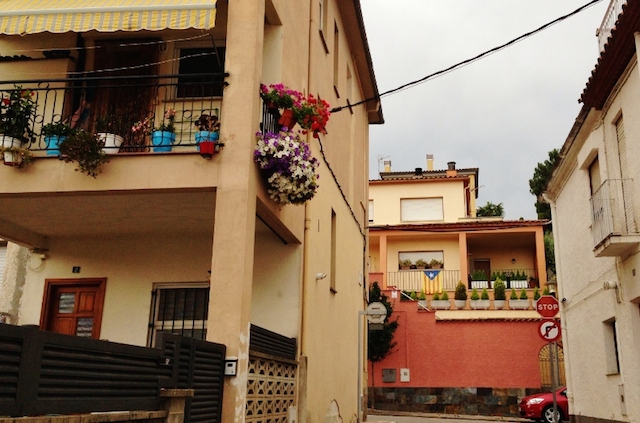
Check out Pink Pangea’s Writing, Yoga, and Meditation Retreats.
In 898, there were known fourteen families inhabiting the valley. As the demographic data shows, the village’s population grew from 91 people in 1497 to 5,560 in 2010. The town fell into decay in 1809, when Napoleon destroyed numerous houses, the church and the notary there.
However, 80 years later it was given the second wind when in 1887 a textile factory appeared. The event radically changed lives of the population, giving a boost to trade unions, labor, cultural and recreational associations.
Today, Anglés is full of brightly-colored, enchanting houses. It seems that every single stone (well, almost) was preserved from the IXth century.
As any patriotic Catalans, the inhabitants of Anglés are proud to hang the national flag of Catalonia on their home balconies. You see it almost everywhere! Even if no one actually sees them except for their neighbors, who are as much patriotic as they are.
Today, Anglés is full of brightly-colored, enchanting houses. It seems that every single stone (well, almost) was preserved from the IXth century.
Another curious feature is the amount of flower gardens the locals grow on their loggias and balconies; a tourist might think there is another competition besides patriotism among the neighbors—whose garden is the most attractive.
The focal point of the town is the Sant Amanç Cathedral. At the moment, the cathedral is under construction, and this chapel functions as a parish church. Historically Anglés emerged around Sant Amanç; people were gathering around it until the village was formed. As you come up the stairs to the chapel, you will see a most remarkable view of old narrow “knotty” streets, gorgeous mountains and bright houses —it is remarkable how diverse a tiny place can be. As King Filipe VI once said, “We all have our place in this diverse Spain”.
Thus, if you are tired of popular touristic destinations, go on exploration of the unknown Catalonia, or just make it one of your stops in your car trip, say, from Barcelona to Andorra.
Planning Your Trip:
Get In: The most convenient way would be to take a train from Barcelona Sants to Girona and then go by taxi, since Anglés is just 18 km away from the latter. It all cost me 50 euros (25 for the train from Barça to Girona and another 25 for a taxi). It is also possible to take a train from Barcelona Sants to Girona, then take a bus from Girona to Osor.
Accommodation: There are just two hotels in Anglés; both are family-run. My choice was Hostal Tarrés, a neat cheap place with nice breakfast and fast wi-fi. One of the hostel’s owners may take you to Girona airport for surcharge. Another option is Hostal Can Massot, which also has high rating.
Dining: L’Alianca d’Angles is the most rated restaurant in the village. Situated in the historic part, it is appreciated for high-quality-and-taste Spanish and Mediterranean food. Restaurante Ca l’Elisa is also worth mentioning. Visitors appreciate it for delicious traditional food.
Sights: View a list of sights to visit here.
Have you traveled to Anglés? What were your impressions? Email us at editor@pinkpangea.com for information about sharing your experience and advice with the Pink Pangea community. We can’t wait to hear from you.
Unknown Catalonia: My Accidental Visit to Anglés photo credits: Aliza Flazleeva

